Requalification of patients with severe asthma for biological therapy—Practical ‘ReQuaBi’ rate decision scheme based on the analytical model
Abstract
Background
Patients with severe asthma experience decreased quality of life due to fixed airway obstruction, hospitalisations and potential fatalities. However, to date, the requalification of severe asthma patients eligible for biological therapy in daily clinical practice remains unstudied.
Objective
The aim of the study was to prepare a universal decision-making algorithm for requalifying patients for biological therapy based on available clinical data obtained from a leading reference centre in Poland.
Methods
All severe asthma patients treated with biologics since 2013 at the Internal Medicine, Asthma and Allergy Department (Medical University of Lodz, Poland), were analysed. The analysis included demographic (age, sex), pre-treatment (reported at qualification: oral glucocorticosteroids use, total IgE serum level, peripheral blood eosinophilia, co-morbidities: atopic dermatitis, chronic allergic rhinitis or sinusitis) and treatment-related data (treatment time, current treatment status, reason for early termination of therapy, year of discontinuation, rediagnostics, requalification).
Results
Rediagnostics were performed in only 4.76% of all requalifications. The following additional data were used to requalify patients: blood eosinophilia (n = 63; 100.00% of requalifications), atopic comorbidities (n = 30; 47.62%) and total IgE serum level (n = 8; 12.70%). Kaplan–Meier curve analysis of all source data revealed the longevity of maintenance as follows: the highest for mepolizumab, then omalizumab, benralizumab, dupilumab and tezepelumab (p = 0.016). Based on the results, requalification model ‘ReQuaBi’, was constructed.
Conclusion
The most important criteria for selecting a biological agent in requalification are peripheral blood eosinophilia, followed by comorbidities and IgE levels. In most cases, extensive additional re-diagnosis may not be necessary.


 求助内容:
求助内容: 应助结果提醒方式:
应助结果提醒方式:


